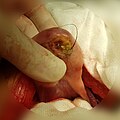Teratoma: Difference between revisions
Replaced content with "{{Infobox medical condition (new) | name = Teratoma | image = Mature cystic teratoma of ovary.jpg | caption = A small (4 cm) dermoid cyst..." Tag: Replaced |
CSV import |
||
| Line 64: | Line 64: | ||
[[Category:Induced stem cells]] | [[Category:Induced stem cells]] | ||
[[Category:RTT]] | [[Category:RTT]] | ||
<gallery> | |||
File:Mature_cystic_teratoma_of_ovary.jpg|Mature cystic teratoma of ovary | |||
File:Ovarian_teratoma_with_hair.jpg|Ovarian teratoma with hair | |||
File:Mature_teratoma,_mediastinum.jpg|Mature teratoma, mediastinum | |||
File:Teratom_001-03.png|Teratoma | |||
File:Teratoma_2_low_mag.jpg|Teratoma | |||
File:Ovarian_tumors_by_incidence_and_cancer_risk.png|Ovarian tumors by incidence and cancer risk | |||
</gallery> | |||
Latest revision as of 10:58, 18 February 2025
| Teratoma | |
|---|---|

| |
| Synonyms | N/A |
| Pronounce | N/A |
| Field | Gynecology, oncology |
| Symptoms | Minimal, painless lump |
| Complications | Ovarian torsion, testicular torsion, hydrops fetalis |
| Onset | |
| Duration | |
| Types | Mature, immature |
| Causes | Unknown |
| Risks | |
| Diagnosis | Tissue biopsy |
| Differential diagnosis | Lipoma, dermoid, myelomeningocele |
| Prevention | |
| Treatment | Surgery, chemotherapy |
| Medication | |
| Prognosis | |
| Frequency | 1 in 30,000 newborns (tailbone) |
| Deaths | |
Teratoma is an intriguing and complex type of neoplasm or tumor that is composed of a diverse array of tissue types. The tumor's distinct tissue types, such as hair, muscle, teeth, or bone, are foreign to the specific area of the body where the teratoma is located. The primary regions where teratomas form are the ovary, testicle, and tailbone, though they can develop in other areas, albeit less commonly.
Introduction[edit]
The term "teratoma" is derived from the Greek words "teras" and "onkoma," which translate to "monster" and "swelling," respectively. This term aptly describes the tumor's often bizarre appearance and composition, containing fully formed body structures such as hair, teeth, and bone.
Clinical Presentation[edit]
Teratomas can range in size and may grow large enough to cause noticeable symptoms or remain small and asymptomatic. A teratoma located in the testicle, for instance, may manifest as a painless lump. The symptoms of a teratoma largely depend on its size and location.
Complications[edit]
The growth and development of a teratoma can lead to complications. For instance, if a teratoma forms in the ovary, it may cause ovarian torsion, a painful condition where the ovary twists around the ligaments that hold it in place, potentially causing a decrease or cut-off in the ovary's blood supply. In males, a testicular teratoma can lead to testicular torsion, a serious condition that requires emergency treatment to restore blood flow and prevent loss of the testicle. In rare cases, a teratoma can also cause hydrops fetalis, a serious fetal condition defined by an abnormal accumulation of fluid in two or more fetal compartments.
Diagnosis and Treatment[edit]
Diagnosis of a teratoma typically involves physical examination, imaging studies such as an ultrasound, and occasionally, a biopsy to confirm the diagnosis. Treatment strategies vary depending on the location and size of the teratoma, but surgical removal is often the preferred treatment option. For malignant teratomas, chemotherapy or radiation therapy may also be recommended.
See Also[edit]
References[edit]
<references/>
|
|
|
| Germ cell tumors | ||||
|---|---|---|---|---|
|
| Tumours of endocrine glands | ||||||||||
|---|---|---|---|---|---|---|---|---|---|---|
|
| Tumors of the female urogenital system | ||||||||||||||||||||
|---|---|---|---|---|---|---|---|---|---|---|---|---|---|---|---|---|---|---|---|---|
|
| * Tumors of the male urogenital system | ||||||
|---|---|---|---|---|---|---|
|
-
Mature cystic teratoma of ovary
-
Ovarian teratoma with hair
-
Mature teratoma, mediastinum
-
Teratoma
-
Teratoma
-
Ovarian tumors by incidence and cancer risk








